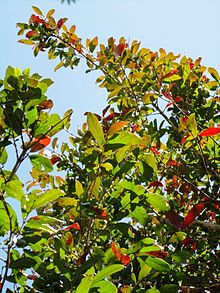Combretum kraussii
| Forest bushwillow | |
|---|---|

| |
| C. kraussii winter foliage | |
| Scientific classification | |
| Kingdom: | Plantae |
| Clade: | Tracheophytes |
| Clade: | Angiosperms |
| Clade: | Eudicots |
| Clade: | Rosids |
| Order: | Myrtales |
| Family: | Combretaceae |
| Genus: | Combretum |
| Species: | C. kraussii
|
| Binomial name | |
| Combretum kraussii | |
| Synonyms[2] | |
| |
Combretum kraussii, the forest bushwillow, is a medium-sized to large tree[3] in the family Combretaceae.[2][4] It is found in eastern South Africa, Eswatini and southern Mozambique, in the vicinity of forests.[5] The specific name commemorates Dr. F. Krauss who undertook a collecting trip to South Africa from 1838 to 1840.[3]
Description
[edit]The trees are semi-deciduous, as spring leaves only partially replace old foliage. These forest trees become conspicuous in late spring, when the fresh leaves turn to a pale, almost white colour, before returning to green by mid-summer.[6] In winter the foliage turns partially red or purple, which is shed just before flowering starts.[7] The fresh clusters of four-winged fruit are a colourful red or yellowy red colour, before they dry to mid-brown.[6]
Biochemical
[edit]Combretastatin B-1, a type of stilbenoid, can be found in C. kraussii.[8]
Relationships
[edit]It is closely related to Combretum nelsonii[5][7] which occurs in rockier habitats, and bears a resemblance to the larger leaved Combretum woodii, which is similarly distributed, but in bushveld.[5]
Gallery
[edit]-
mature tree
-
red winter foliage
-
fruit
-
dry fruit in winter
References
[edit]- ^ Botanic Gardens Conservation International (BGCI) & IUCN SSC Global Tree Specialist Group (2021). "Combretum kraussii". IUCN Red List of Threatened Species. 2021: e.T146456269A208438144. doi:10.2305/IUCN.UK.2021-3.RLTS.T146456269A208438144.en. Retrieved December 13, 2024.
- ^ a b "Combretum kraussii Hochst". Plants of the World Online. The Trustees of the Royal Botanic Gardens, Kew. n.d. Retrieved December 13, 2024.
- ^ a b Le Roux, Lou-Nita; et al. "Combretum kraussii". Retrieved 14 October 2011.
- ^ "Combretum kraussii Hochst". Catalogue of Life. Species 2000. n.d. Retrieved December 13, 2024.
- ^ a b c Van Wyk, Braam, Piet (1997). Field Guide to the Trees of Southern Africa. Cape Town: Struik. p. 332. ISBN 1-86825-922-6.
{{cite book}}: CS1 maint: multiple names: authors list (link) - ^ a b Palgrave, K.C. (1984). Trees of Southern Africa. Cape Town: Struik. p. 670. ISBN 0-86977-081-0.
- ^ a b Pooley, Elsa (1997). The Complete Field Guide to Trees of Natal, Zululand & Transkei. Durban: Natal Flora Publications Trust. p. 358. ISBN 0-620-17697-0.
- ^ Uteroactive constituents from Combretum kraussii. Bridget K Brookes, Olga V Doudoukina, Lynn C Katsoulis and Joy H D Veale, South African Journal of Chemistry, Dec 99, Vol. 52, Issue 4, page 127 (abstract)





